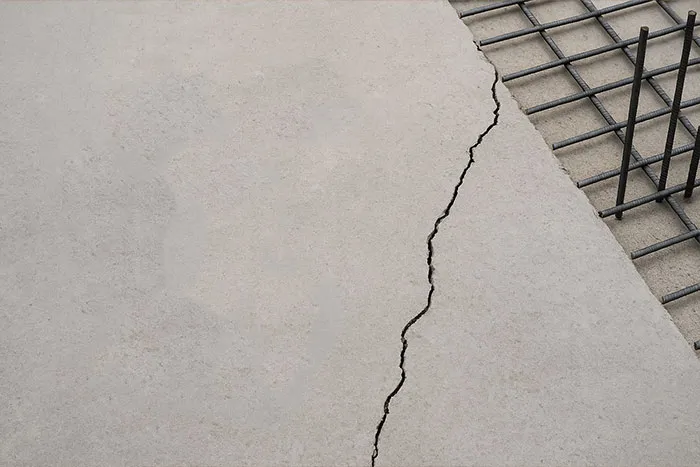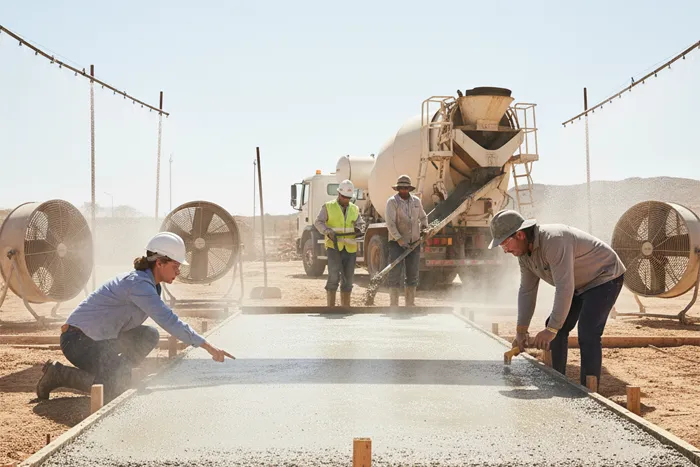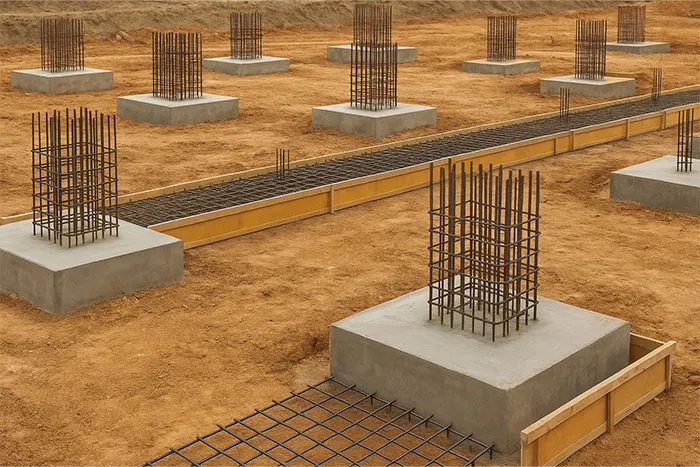
- Published:
- Written by: B.F.S Industries
Introduction to Concrete Pouring Methods

FREE DOWNLOAD – B.F.S. HOLDING
Explore the full spectrum of services and industries covered by B.F.S. Holding.
Concrete Pouring, or concrete placement, is one of the most crucial stages in the creation of any reinforced concrete structure. It determines the structure’s strength, durability, and performance over time. This process transforms a liquid mixture into a solid mass capable of withstanding loads and environmental conditions. Selecting the right pouring method and executing it with precision is key to achieving long-term structural success.

Effective management of the placement operation requires a specialized understanding of the material’s behavior in its fluid state, including factors that can lead to early setting or, conversely, excessive bleeding. The goal of every construction team must be to ensure that the concrete is deposited close to its final resting place in continuous, horizontal layers, avoiding unnecessary lateral movement after deposition, which can induce segregation. Given the complex nature of large-scale projects, such as those handled by leading infrastructure suppliers, continuous communication between the batching plant, transport vehicles, and the site team is essential to guarantee a sustained supply without overloading the placement crew or allowing excessive gaps between deliveries. This technical foresight ensures that the concrete placement is efficient, preserves the quality established by the initial mix design, and ultimately delivers a solid foundation ready for the crucial consolidation and curing phases that follow immediately after placement. The success of the entire structure hinges on the mastery displayed during this relatively short window of opportunity.
Importance of Proper Concrete Pouring
The integrity of a concrete structure is irrevocably decided during the pouring and placement stage; errors here cannot be easily corrected post-set, leading to permanent structural deficiencies that compromise the design life and necessitate costly future repairs. Proper concrete pouring ensures that the material achieves its full specified design strength by eliminating internal voids and achieving intimate contact with all reinforcing elements and the formwork surfaces. When concrete is placed incorrectly, it often leads to defects such as localized segregation, where the heavier aggregate separates from the cement paste, resulting in non-uniform strength and permeability. This segregation creates pathways for moisture and corrosive agents to penetrate the structure, significantly accelerating the deterioration of the concrete itself and promoting the corrosion of the embedded reinforcing steel. Consequently, the long-term performance and the structure’s resistance to environmental factors like freeze-thaw cycles or chemical attack are dramatically reduced, falling short of the intended durability requirements set out by the design specifications.

Furthermore, correct placement is essential for preventing the formation of ‘cold joints,’ which occur when a new layer of concrete is placed against a layer that has already begun to set, resulting in a weak, poorly bonded plane within the element. This discontinuity acts as a structural fault line and a highly permeable zone, undermining the monolithic nature required of all robust concrete elements. For contractors focused on producing high-quality precast and structural components, adherence to best practices in pouring minimizes the risk of cosmetic defects like honeycombing and surface blemishes, which are telltale signs of poor consolidation or improper handling. Employing expert suppliers, such as those found at bfs industries, who specialize in high-precision concrete equipment and placement solutions, significantly reduces these risks. A professional, systematic pouring process is, therefore, not merely a construction activity but a non-negotiable quality control measure that ensures the finished product possesses the requisite load-bearing capacity and resilience for its entire service life.
Preparation Before Pouring Concrete
Meticulous preparation of the site and materials is the foundation upon which a successful and durable concrete pour is built, demanding rigorous inspection and verification of all pre-placement activities. The primary focus of preparation revolves around the formwork and the embedded reinforcement. The formwork system, often detailed in a comprehensive Shuttering Material List, must be precisely aligned, rigidly braced, and securely sealed to prevent any loss of cement paste, a condition known as “leaching,” which drastically weakens the resulting concrete. Inspections must confirm that all required release agents have been uniformly applied to the internal faces of the formwork to facilitate clean formwork removal without damaging the concrete surface. For vertical elements, the construction of intricate systems like the Concrete Column Formwork must be checked for plumbness and sufficient bracing to withstand the hydrostatic pressure exerted by the plastic concrete during placement and vibration.

In tandem with formwork checks, the steel reinforcement must be thoroughly inspected for correct spacing, lap lengths, and specified concrete cover, ensuring that the necessary clearance is maintained between the steel, the formwork, and any embedded items. Cleanliness is non-negotiable; all debris, dirt, sawdust, ice, or standing water must be completely removed from the placement area, as contaminants can negatively affect hydration and bond strength. Just prior to the arrival of the concrete, the subgrade or existing concrete surface should be sufficiently dampened, not saturated, to prevent it from rapidly drawing water out of the fresh mixture, which could compromise the specified water-cement ratio and increase the risk of shrinkage cracking. Finally, the site team must verify all tools—including vibrators, screeds, and testing apparatus—are operational, and that access routes are clear, allowing for an uninterrupted and efficient flow of operations once the first batch of concrete arrives on site.
Understanding the Main Concrete Pouring Methods
The selection of a concrete pouring method is a fundamental logistical and engineering decision that must be based on the project’s scale, the element’s geometry, and the accessibility of the pour location. One of the most common methods for shallow pours and flatwork is direct discharge via chute from the transit mixer. While simple and cost-effective, this method requires careful management of the chuting angle and discharge height to prevent the concrete from impacting the forms or the ground forcefully, which can induce severe segregation. For projects involving vertical transportation or significant horizontal reach, concrete pumping is the preferred high-efficiency method, utilizing either a truck-mounted boom pump for versatility or a stationary line pump for long-distance conveyance. Pumping subjects the concrete to high pressure, making it imperative that the mix design is pumpable, often requiring specialized admixtures to enhance flowability without increasing the water content, ensuring a consistent and reliable flow rate into the formwork.
This podcast explores various Concrete Pouring Methods, discussing techniques, equipment, and best practices for efficient and durable construction.
For massive structures or high-rise construction where pumping might not be feasible or where the volume capacity of the pump is insufficient, the crane and bucket method remains a robust and highly controlled technique. This involves transporting large batches of concrete, often up to four cubic yards at a time, using specialized bottom-dump buckets lifted by a crane. This method is exceptionally suitable for highly complex or remote placements, such as large water retention elements where expertise from a dam formwork supplier is essential, as the bucket placement allows for very precise control over the drop height, minimizing segregation risks. Another increasingly utilized method is the use of high-speed conveyor belts, which are particularly effective for placing large volumes of concrete in trenches, on grade, or in bridge decks over moderate distances. Each method, from the simplicity of chuting to the complexity of pressure pumping, demands a tailored approach to monitoring and flow management to guarantee the integrity of the fresh concrete mixture is maintained right up to the point of final consolidation.
1. Direct Discharge via Chute
Used in small or medium projects for shallow pours. The concrete is discharged directly from the mixer through a chute. To prevent segregation:
- Limit discharge height to under 1.5 meters.
- Avoid sharp turns or long chutes.
2. Concrete Pumping
A modern and efficient technique for vertical or horizontal transportation. It involves truck-mounted boom pumps or stationary line pumps.
- Mix must be pumpable, with adequate flowability.
- Ideal for high-rise or congested sites.
- Reduces labor and speeds up placement.
3. Crane and Bucket Method
For large-scale or complex pours where pumping isn’t feasible.
- Buckets carry 1–4 cubic yards of concrete.
- Offers precise control over placement.
- Common in dam construction or high-rise cores.
4. Conveyor Belt Method
Suitable for continuous, large-volume placement such as slabs, bridge decks, or trenches.
- Reduces handling and improves uniformity.
Step-by-Step Process of Pouring Concrete
The pouring process begins immediately upon the transit mixer’s arrival, starting with the mandated verification checks to confirm the mix’s compliance with project specifications. Before discharge, a representative sample of the concrete must be subjected to a slump test to measure its workability and consistency, ensuring it falls within the permissible range specified by the engineer. Once verified, placement must commence without delay. The concrete should be placed as close as possible to its final position to minimize handling and lateral spreading, which can lead to segregation and paste migration. Crucially, the concrete must be placed in horizontal layers of uniform thickness, typically ranging from 300 mm to 500 mm, ensuring that the pour remains continuous and that each new layer is placed and consolidated before the preceding layer reaches its initial set, thereby preventing the formation of cold joints across the entire pour volume.

Immediately following placement, the most vital activity for achieving a durable structure is consolidation, typically performed using mechanical immersion vibrators. The vibrator head must be inserted rapidly and systematically, penetrating into the underlying layer to thoroughly blend the fresh concrete with the previously placed concrete and expel all entrapped air. The withdrawal rate of the vibrator must be slow and steady to allow the air bubbles to escape, and the vibrator should be spaced appropriately to ensure that the radius of influence of each insertion overlaps, guaranteeing complete compaction across the entire lift. Adequate vibration is signaled by a visible sheen on the concrete surface and the cessation of large air bubbles rising, but it must be performed judiciously; excessive vibration can lead to localized segregation and bleeding. Following consolidation, the concrete is “struck off” using a straightedge to achieve the required elevation, followed by an initial floating process to consolidate the surface paste and remove minor imperfections, setting the stage for final finishing.
Common Challenges and How to Avoid Them
Several common challenges threaten the quality of a concrete pour, all of which stem from improper handling, placement, or inadequate consolidation, fundamentally undermining the material’s strength and resilience. The most frequent and damaging challenge is segregation, which is the separation of the coarse aggregate from the finer materials and paste. This typically occurs when concrete is dropped from an excessive height, allowed to run and flow over long distances, or subjected to over-vibration. To mitigate this, construction teams must limit the vertical free fall of the concrete—ideally to less than one meter—and employ drop chutes or tremies for deeper elements like caissons or retaining walls, ensuring the discharge point is always submerged beneath the fresh concrete surface. Another persistent challenge is the occurrence of honeycombing and voids, primarily observed at the intersection of dense reinforcement or near formwork faces, which is an unmistakable sign of insufficient vibration.
To proactively avoid honeycombing, the placement crew must ensure that the vibrators are appropriately sized for the aggregate and reinforcement density, and that the vibration sequence is systematic, ensuring every part of the concrete element is reached. Moreover, the timing of the pour must be carefully managed to prevent the formation of cold joints, which are structurally weak planes that arise when the elapsed time between placing successive lifts exceeds the initial setting time of the concrete. This challenge is overcome by maintaining a consistent supply of concrete through efficient batching process management and coordinating the placement speed to match the setting characteristics of the mix, especially in hot weather conditions where the setting time is significantly accelerated. By implementing these rigorous control measures, including careful flow management and vigilant consolidation, structural integrity is preserved, and the need for future remedial patching is drastically reduced, ensuring a high-quality finished product.
| Problem | Cause | Solution |
|---|---|---|
| Segregation | High fall height, over-vibration | Use tremie or limit fall to <1.5 m |
| Honeycombing | Poor compaction, dense reinforcement | Use proper vibration and workable mix |
| Cold joints | Delay between layers (>30 min) | Maintain continuous supply and sequence |
| Bleeding | Excess water or over-finishing | Control mix water and avoid overworking surface |
Curing and Finishing for Maximum Durability
Curing is the post-placement phase that is fundamentally essential for maximizing the structural integrity, long-term durability, and surface hardness of the concrete structure. The process involves maintaining a satisfactory temperature and adequate moisture content within the concrete for a defined curing period, allowing the cement hydration process to proceed fully and efficiently. Without proper curing, the surface of the concrete can dry out prematurely, leading to a weak, porous crust that is susceptible to dusting, abrasion, and plastic shrinkage cracking. Effective curing methods include ponding or continuous sprinkling, covering the surface with wet burlap, or applying chemical liquid membrane-forming curing compounds that seal the moisture within the concrete. For mass concrete structures, managing the internal temperature gradient through controlled curing is vital to prevent thermal cracking, which can compromise the element’s water-tightness and structural performance.
The finishing process, which immediately follows placement and consolidation, is equally crucial for aesthetic quality and serviceability. Initial floating removes humps and hollows and prepares the surface for final finishing, but it must be performed only after the concrete has lost its surface bleed water and attained sufficient stiffness to support the weight of the finisher. Final finishing techniques, such as troweling, are employed to achieve a dense, smooth, and hard-wearing surface, essential for floors or paving. However, overworking the surface can draw excessive fines and water to the top, leading to weak surface layers that are prone to scaling and crazing. The stripping of formwork, or formwork removal, must also be considered part of this phase, and is governed by strict criteria based on the concrete’s measured compressive strength, typically requiring a minimum percentage of the specified design strength before supports can be safely removed, preventing premature loading and potential collapse or damage to the green concrete element.
Conclusion: Achieving Strong and Long-Lasting Concrete Structures
The execution of high-quality concrete structures is a direct summation of the meticulous planning, informed methodology, and professional execution displayed during the entire cycle of pouring and placement. As demonstrated, achieving strong and long-lasting concrete is a continuous chain of quality control, extending from the initial verification of the mix design and the batching process to the final, critical stages of consolidation and curing. For civil engineers and construction managers, the responsibility lies in selecting the most appropriate placement method—whether pumping, craning, or direct discharge—based on site-specific parameters, and rigidly adhering to best practices, particularly concerning the control of placement height to prevent segregation. The proactive implementation of mitigation strategies against common defects like honeycombing, cold joints, and excessive bleeding is what ultimately separates a standard pour from a structurally exceptional one, guaranteeing that the completed element will perform as designed.
The economic benefits of quality concrete placement are substantial and far-reaching, encompassing not only the avoidance of expensive structural remediation but also the realization of the full design life and minimized maintenance requirements for the finished facility. By maintaining stringent quality standards, ensuring thorough consolidation through systematic vibration, and dedicating adequate resources to a controlled curing period, construction professionals ensure the highest levels of structural integrity and durability. Ultimately, the successful execution of any project rests upon the principle that the placement of the plastic concrete must be treated with the same engineering precision as the structural design itself. By viewing the pouring phase not as a simple delivery task but as a sophisticated process of material transformation, the construction industry can consistently deliver the resilient infrastructure required for modern, long-term development.


